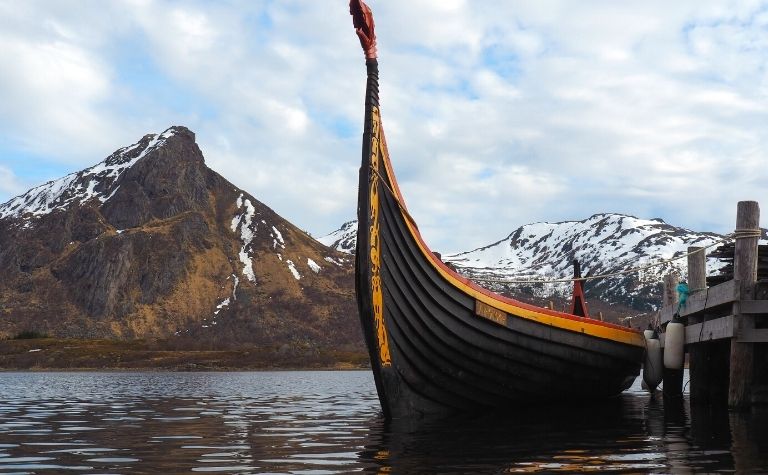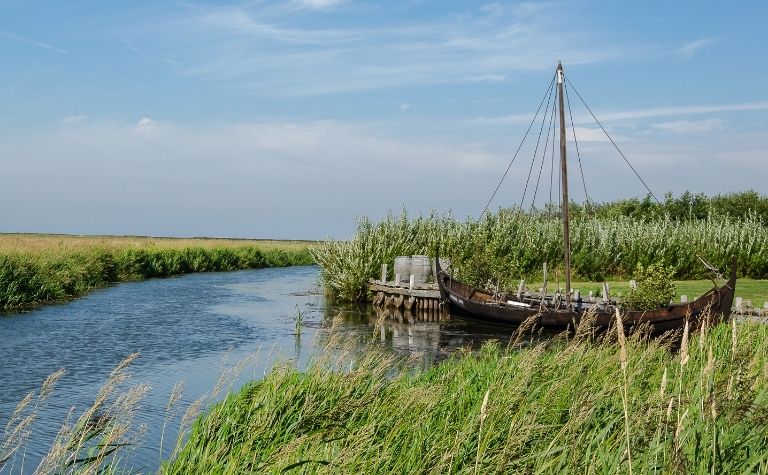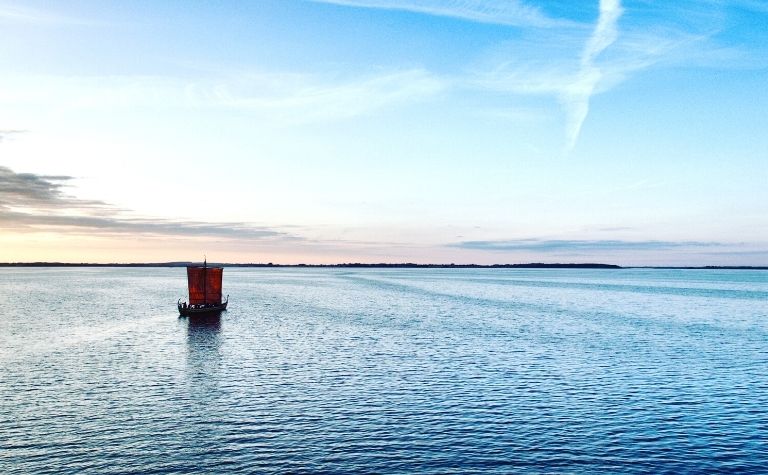Vikings could be brutal and violent as they sought to carve out their slice of the frontier. Accomplishing this was no small feat and required logistical organization.
It took a handful of men to perform executions, prepare defenses, and do similar tasks.
The Viking society changed over time as their culture permeated Northern Europe and beyond.
The Viking hierarchy was split into social classes.
The enslaved people were at the bottom of the hierarchy, also known as Thralls. Next came the Karls, the middle class, and the farmers and tradespeople.
Above them were the Jarls, followed by the Royals, the highest of Viking society.
Many people might have been curious about the Vikings and their interesting class system.
There is more to the Vikings than pillaging and plundering; they had a complex class system that we are still learning about today.
Also see Famous Vikings Kings and Leaders to learn more.

What Was The Vikings’ Social Hierarchy?
The Viking social structure comprised four levels of classes.
At the bottom of the structure were the enslaved people. Above the enslaved people were the Karls, the farmers, blacksmiths, and tradespeople.
In the middle were the Earls, and on top were the royals such as the Kings and Queens.
If a Viking were born into any of these classes, they weren’t stuck in that chosen class for the rest of their life.
It was feasible to move up or down the hierarchy depending on their choices in life.
Being an enslaved person during the Viking era was not a good place to be as the enslaved people had no personal freedom.
Enslaved people were at the mercy of their owners, and they could do almost anything they wanted with you.
The god Heimdal was said to have created the four societal classes while he traveled through Midgard (Middle Earth) under the name Rig, while in disguise.
The story goes that Rig visited three different homesteads and received hospitality from each couple residing in each home.
Rig slept in the same beds as the Viking couples, lying between each of those couples for three nights.
Later, a boy was born from each couple, with each boy representing one of the Viking social classes.
The first home that Rig visited lived a poor couple, and they ate soup and a loaf of bread stuffed with grains.
Their names were Ai (Great grandfather) and Edda (Great grandmother).
The boy born from this home was unsightly and had a crooked back.
He was named Thrall, meaning enslaved person.
Thrall grew up doing menial work such as feeding the animals and gathering firewood.
One day, Thrall met a woman named Thir who was described as dirty, with scars on her feet, a bent nose, and sunburnt arms.
They had children of their own, and their children grew up doing menial work and became enslaved people.
Rig’s next home was a lot better than the first house and was occupied by a couple named Afi (Grandfather) and Amma (Grandmother).
Rig spent three nights with the couple, and nine months later, Amma gave birth to a boy with red hair and bright eyes.
The boy was named Karl. Karl grew up doing farming and other farm-related work like herding cattle and plowing the fields.
Rig traveled to the next home, which was large, luxurious, and more comfortable than the previous two homes.
Also see Why Did the Vikings Die Out? to learn more.
He was invited into the home by a couple named, Modir (Mother) and Fadir (Father).
The couple was well dressed. The woman wore jewelry, a headscarf, a long dress, and a blue blouse.
Blue dye was quite expensive during the Viking age, so wearing blue clothing was a sign of wealth.
The woman was beautiful, with skin as white as snow.
White skin was associated with beauty as it was a sign that she did not work in the sun, like the other two classes of Vikings.
Rig ate with the couple, and the food consisted of sliced white bread, meat, poultry, and drank wine.
Rig slept with the couple, and nine months later, Modir gave birth to a boy named Jarl.
The boy had blond hair, bright cheeks, and snake-like eyes. Jarl’s father taught him to hunt, ride horses, throw and fight with a sword.
As Jarl grew older, Rig visited him several times, teaching him to fight, conquer lands and read runes.
Jarl married a woman named Erna (Eagle Lady), who was described as intelligent and white with soft hands.
They had many children together, but their last son was the most important.
His name was Konr, meaning King.
The story clarifies how the Vikings believed that the social classes came into existence.
So, the Thralls, or enslaved people, were at the bottom of the hierarchy. The Karls, the farmers, blacksmiths, and tradespeople were higher than Thralls.
The Jarls were the noble class and did not do any physical labor. Finally, the royalty class was descendants of the Konr.
Also see Did Vikings Share Their Wives? to learn more.

Viking Women In The Social Hierarchy
In the Viking social structure, women had as much freedom as their husbands and male counterparts.
Women were allowed to own property, request a divorce from their husbands, and perform business transactions.
Viking women could also move up the hierarchy to a higher status of a Jarl.
What Was The Viking’s Military Structure?
Viking warriors came from the class of free men, who were young men with little to no wealth and went on raids to acquire some wealth in the form of silver or land to farm.
They were generally single and unmarried and had no duties tying them down to a farm or a domestic lifestyle.
The Viking military structure originated from warlords, known as drotts.
A drott was an earned title of respect, not an inherited one.
Viking warriors chose their most adept leader and pledged their allegiance to him. Other members within the Viking military were:
- Drang or Dreng. A young warrior (plural droengiar)
- Thegn. A mature warrior (plural thegnar)
- Skeppare. A captain of a chiefly vessel
- Himthiki. Housekarls or the lowest rank of elite soldiers
- Folc. The population of a settlement
Women were also allowed to fight alongside the men, and female warriors were known as shield maidens.
Also see Were the Vikings German? to learn more.

Who Were The Vikings’ Best Leaders?
The Vikings are considered one of the most fearsome invaders in European history.
Led by their fearless leaders, these Scandinavian pirates from Denmark, Sweden and Norway raided across England, Scotland, Ireland, and much of northern parts of Europe.
The Vikings are widely known for their ferocity in battle, and throughout history, a few notable leaders have fought bravely and led fearsome armies into battle for victory and loss.
A few memorable Viking leaders are listed below:
Rollo, The First Ruler Of Normandy
In 911 A.D., Charles the Simple King of the West Franks bestowed upon Rollo part of the land now known as Normandy in an effort for him to protect it from other Viking plunderers.
Rollo later expanded his region of control until the time of his death in 928 CE, with his son William Longsword succeeding him.
In 1066, another one of Rollos descendants, William the Duke of Normandy, successfully led an invasion of England.
Later, he became known as William the Conquerer and became King of England and ruled until 1087.
Also see Did the Vikings Fight the Mongols? to learn more.
Erik, the Red, Founder of Greenland’s First Norse Settlement
Erik Thorvaldsson, born in Norway, earned his nickname “Erik the Red” from his red hair and hot temper.
Erik fled Norway to Iceland with his family after his father was accused of killing someone.
Around 982 A.D., Erik was similarly accused of manslaughter, resulting in being exiled from Iceland.
He sailed west to an uncharted island which he eventually called Greenland to try and entice settlers to make their home there.
Many years later, Erik returned to Iceland and organized a fleet of twenty-five ships carrying colonists to Greenland, where they founded two villages in 986.
The Greenland colony had an estimated five thousand settlers at its peak.
After Erik’s death, Greenland’s Norse community abandoned their homes between the 14th to 15th centuries.
It is not fully known why the Norse Greenlanders abandoned their colony, but a few factors like cooling climate and declining trade can be attributed to the abandonment.
Olaf Tryggvason, Brought Christianity to Norway
Olaf Tryggvason, the grandson of Harald Fairhair, was the first King to unite Norway.
Olaf was born in 968 A.D. and was believed to have been raised in Russia after his father’s death. In 991, Olaf led an invasion of England to victory at the Battle of Maldon.
The English later paid off the Vikings to prevent future attacks.
This payment became known as Danegeld. In 994 CE, Olaf and his ally, Svein Forkbeard, the King of Denmark, started another attack on England and gained more Danegeld.
The year after the attack, Olaf used his Danegeld to invade Norway and was crowned King after its ruler Hakon The Great, was killed.
As the new King of Norway, Olaf used his authority to force his kinsmen to convert to Christianity.
The Scandanavians were originally pagans that worshipped various gods.
Olaf’s decisions and actions garnered many enemies, including his ally, Svein Forkbeard, who wished to restore Danish rule to Norway.
In 1000, Olaf was ambushed by his enemies while at sea. Instead of surrendering, Olaf jumped overboard and was never seen again.
Conclusion
In many ways, the Vikings were the rock stars of their time.
They had that cool-guy appeal with a bad-boy edge and a desire to explore and discover new lands.
They were warriors, explorers, farmers, and even poets.
The Viking’s ranks set them above other members of society and made them stand out as individuals that did extraordinary things on behalf of their community.
Also see Did the Vikings Travel to Asia? to learn more.
